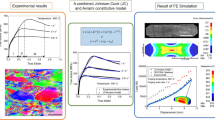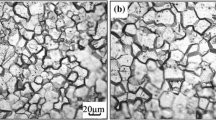Abstract
Inverse analysis is a method for determining material parameters by minimizing the difference between experimental and the finite element (FE) simulated results, such as the load-stroke curve and barreling shape of a deformed specimen using an optimum design technique. In this study, ring compression tests were conducted to predict the flow stress of materials and interfacial friction conditions. Cylinder compression tests were conducted under the same process conditions to estimate the validity of the data obtained from the ring compression tests. By comparing the experimental results with the FE simulated results, it was confirmed that flow stress and the interfacial friction condition obtained from the ring compression tests, as well as their inverse analysis, are quite reasonable. The validity of both the flow stress function and the interfacial friction condition using the above procedures was verified by the experiments.
Similar content being viewed by others
References
Y. Choi, H. K Kim, H. Y Cho, B. M Kim and J. C Choi, A method of determining flow stress and friction factor using an inverse analysis in ring compression test, Journal of KSTP, 22 (1998) 483–492.
T. Altan, G. Ngaile and G. Shen, Cold and hot forging fundamentals and application, ASM. International, (2005) 25–49, 67–89.
T. Altan, Material properties and cold forging lubricants, Prepared for 2nd Cold and Warm precision Forging Workshop, (2004).
T. Altan and H. J. Cho, Simultaneous determination of flow stress and interface friction by finite element based inverse analysis, Prepared for 53rd CIRP General Assembly, (2003).
T. Altan and H. J. Cho, Determination of flow stress and interface friction at elevated temperature by inverse analysis technique, 2003, J. Mater. Process.Technol., 170 (2003) 64–70.
R. Ebrahimi and A. Najafizadeh, A new method for evaluation of friction in bulk metal forming, J. Mater. Process. Technol., 152 (2004) 136–143.
S. Y. Lin and F. C. Lin, Prediction of fold defect in barreling formation of cylinder upsetting, Finite Element in Analysis and Design, 39 (2003) 325–341.
S. Y. Lin and F. C. Lin, Influence of the geometrical conditions of die and workpiece on the barreling formation during forging-extrusion process, J. Mater. Process. Technol., 140 (2003) 54–58.
K. M. Kulkarni and S. Kalpakjian, A study of barreling as an example of free deformation in plastic working, Journal of Engineering for Industry., 104 (1982) 79–83.
J. A. Schey, T. R. Venner and S. L. Takomana, Shape changes in the upsetting of slender cylinders, Journal of Engineering for Industry, 104 (1982) 79–83.
J. K. Banerjee, Barreling of solid cylinders under axial compression, Transaction of the ASME., 107 (1985) 138–144.
F. K. Chen and C. J. Chen, On the nonuniform deformation of the cylinder compression test, Transaction of the ASME., 122 (2000) 192–197.
R. Narayanasamy, R. S. N. Murthy, K. Viswabatham and G. R. Chary, Prediction of the barreling of solid cylinders under uniaxial compressive load, Journal of Mechanical Working Technology., 16 (1988) 21–30.
R. Narayanasamy, K. S. Pandey, Phenomenon of barreling in aluminium solid cylinders during cold upset forming, J. Mater. Process. Thecnol., 70 (1997) 17–21.
R. Narayanasamy, S. Sathiyanatayanan and R. Ponalagusamy, A study on barreling in magnesium alloy solid cylinders during cold upset forming, J. Mater. Process. Technol., 101 (2000) 64–69.
S. Malayappan and R. Narayanasamy, An experimental analysis of upset forming of aluminium cylindrical billets considering the dissimilar frictional conditions at flat die surfaces, Int. J. Adv. Manuf. Technol., 23 (2004) 636–643.
N. Kim and H. Choi, The prediction of deformation behavior and interfacial friction under hot working conditions using inverse analysis, J. Mater. Process. Technol., (2007) be under examination.
C. M. Sellars, The kinetics of softening processes during hot working of austenite, Czech J. Phys. B35 (1984) 57–70.
Y. Estrin and H. Mecking, An unified phenomenological description of work hardening and creep based on one-parameter models, Acta Metall. 32 (1984) 57–70.
R. Colas, High temperature deformation of low carbon steels, Mater. Forum (1990) 14–253.
K. P. Rao and E. B. Hewbolt, Development of constitutive relationships using compression testing of a medium carbon steel, ASME, Journal of engineering materials technology, (1992) 114–116.
B. Kowalsksi, C. M. Sellars and M. Pietrzyk, Development of a computer code for the interpretation of results of hot plane strain compression tests, ISIJ Int. 40 (2000) 1230–1236.
J. G. Lenard, M. Pietrzyk and L. Cser, Mathematical and physical simulation of the properties of hot rolled products, Elsevier, Amsterdam, (1999).
D. Szeliga, J. Gawad and M. Pietrzyk, Inverse analysis for identification of rheological and friction models in metal forming, J. Comput. Methods Appl. Mech. Eng., 195 (2006) 6778–6798
J. S. Arora, Introdution to optimum design, Elsevier Academic Press, (2005).
R. C. Gomzalez, R. E. Woods and S. L. Eddins, Digital image processing using MATLAB, Prentice Hall, (2004).
Author information
Authors and Affiliations
Corresponding author
Additional information
This paper was recommended for publication in revised form by Associate Editor Youngseog Lee
Mr. Kyoungmin Shin received his B.S. and M.S. degree from the department of Mechanical Engineering, Sogang University, Seoul, S. Korea in 2006 and 2009, respectively. Mr. Seo is currently working for Hyundai Engineering. His research interests are in the area of optimum design of electric motors, metal forming, and process design.
Naksoo Kim received his B.S. and M.S. degree from the department of Mechanical Design, Seoul National University in 1982 and 1984, respectively. He then went on to receive his Ph. D. degree from U.C. Berkeley. Dr. Kim had worked for the ERC/NSM at the Ohio State University as a senior researcher and Hongik University as an assistant professor. He is currently a professor at the department of mechanical engineering, Sogang University. Dr. Kim’s research interests are in the area of metal forming plasticity, computer aided process analysis, and optimal design
Rights and permissions
About this article
Cite this article
Shin, K., Chi, S. & Kim, N. Prediction of flow stress of metallic material and interfacial friction condition at high temperature using inverse analysis. J Mech Sci Technol 24, 639–648 (2010). https://doi.org/10.1007/s12206-010-0110-4
Received:
Revised:
Accepted:
Published:
Issue Date:
DOI: https://doi.org/10.1007/s12206-010-0110-4




